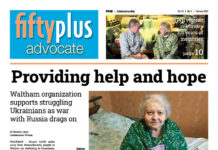By Lauran Neergaard
WASHINGTON —
The clock is ticking: The first National Alzheimer’s Plan sets a deadline of 2025 to finally find effective ways to treat, or at least stall, the mind-destroying disease.
The Obama administration is finalizing the landmark national strategy today, laying out numerous steps the government and private partners can take over the coming years to fight what is poised to become a defining disease of the rapidly aging population.
But some of the work is beginning right away.
Starting today, embattled families and caregivers can check a new one-stop website — www.alzheimers.gov — for easy-to-understand information about dementia and where to get help in their own communities.
The National Institutes of Health (NIH) is funding some major new studies of possible therapies, including a form of insulin that’s squirted into the nose.
“These actions are the cornerstones of an historic effort to fight Alzheimer’s disease,” Health and Human Services (HHS) Secretary Kathleen Sebelius said in a statement. She was announcing the steps Tuesday at the NIH.
The first National Alzheimer’s Plan comes as the world’s top Alzheimer’s scientists are gathered at the NIH this week to debate what research needs to be given priority in order to meet that ambitious 2025 deadline. They said it may be time to start testing potential therapies differently, before people have full-blown Alzheimer’s symptoms, when it may be too late to help.
“There’s a sense of optimism” thanks to some new discoveries, Dr. Francis Collins, director of the NIH, told scientists at the Alzheimer’s Research Summit on Monday.
But, “we need to figure out exactly where is the best window of opportunity” to battle back Alzheimer’s, Collins said. He noted that cardiologists don’t test cholesterol-lowering drugs on people already near death from heart failure.
It’s clear that Alzheimer’s quietly brews in the brain, killing off cells, for 10 years or more before symptoms appear, Dr. Reisa Sperling of Harvard Medical School told the meeting. She called that time period an important opportunity to try to stave off the disease, at least postponing the memory loss and other symptoms.
Already, 5.4 million Americans have Alzheimer’s or related dementias. Barring a research breakthrough, those numbers will rise significantly by 2050, when up to 16 million Americans are projected to have Alzheimer’s. Already, it’s the sixth-leading killer, and there is no cure. Treatments only temporarily ease some symptoms.
Beyond the suffering, it’s a budget-busting disease for Medicare, Medicaid and families. Caring for people with dementia will cost the U.S. $200 billion this year alone, and $1 trillion by 2050, the Alzheimer’s Association estimates. Even that staggering figure doesn’t fully reflect the toll. Sufferers lose the ability to do the simplest activities of daily life and can survive that way for a decade or more. Family members provide most of the care, unpaid, and too often their own health crumbles under the stress.
So the National Alzheimer’s Plan, required by Congress, takes a two-pronged approach: focusing on future treatments plus help for families suffering today.
“There is a reinvigorated focus on this disease,” Donald Moulds of HHS told The Associated Press.
Among the first steps:
•A planned $8 million study of an insulin nasal spray that pilot-testing suggests could help Alzheimer’s. It’s based on growing evidence that diabetes and Alzheimer’s are related, damaging how the brain is fueled. The insulin nasal spray can reach the brain without affecting blood-sugar levels.
•Also, NIH was contributing $16 million to an international study of whether a treatment targeting amyloid, Alzheimer’s hallmark brain plaque, could prevent the disease. The study will include people at highest risk, genetically, of the disease, including Americans and a unique group in Colombia.
•The government will begin offering training to doctors and other health providers on the best ways to care for patients and their families.
Beyond the initial steps, the plan lays out ways that federal and state governments plus private and nonprofit organizations can collaborate to battle Alzheimer’s — from improving early diagnosis to creating more resources to help families with long-term care of their loved ones at home. — AP












